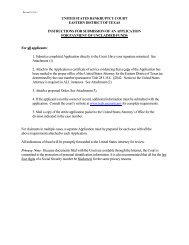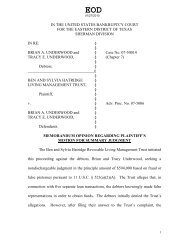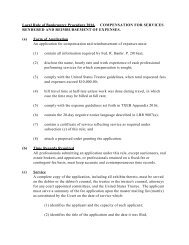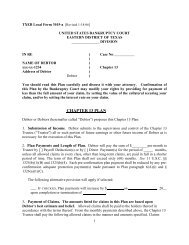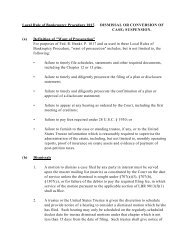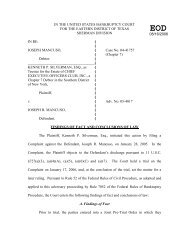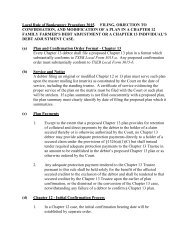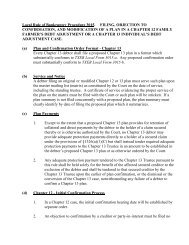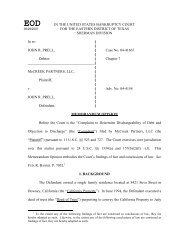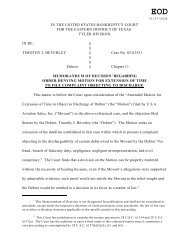FINDINGS OF FACT AND CONCLUSIONS OF LAW This matter is ...
FINDINGS OF FACT AND CONCLUSIONS OF LAW This matter is ...
FINDINGS OF FACT AND CONCLUSIONS OF LAW This matter is ...
Create successful ePaper yourself
Turn your PDF publications into a flip-book with our unique Google optimized e-Paper software.
EOD02/21/2007IN THE UNITED STATES BANKRUPTCY COURTEASTERN DISTRICT <strong>OF</strong> TEXASSHERMAN DIVISIONIN RE:NORMAN MICHAEL MILLER<strong>AND</strong> SHERI PRATER MILLERaka MIKE MILLER,d/b/a M CCORP INTERNATIONALTRUST,DEBTORS.____________________________NEIL LEWIS <strong>AND</strong> SHARONLEWIS d/b/a S.D.I.C.,v.Plaintiffs,NORMAN MICHAEL MILLERand SHERI PRATER MILLER,Defendants.'''''''''''''''''''''''CASE NUMBER: 04-45468-RCHAPTER 7JUDGE BRENDA T. RHOADES________________________________________ADVERSARY NO: 05-04044<strong>FINDINGS</strong> <strong>OF</strong> <strong>FACT</strong> <strong>AND</strong> <strong>CONCLUSIONS</strong> <strong>OF</strong> <strong>LAW</strong> 1<strong>Th<strong>is</strong></strong> <strong>matter</strong> <strong>is</strong> before the Court following the trial of the Complaint to Object toD<strong>is</strong>charge, as amended (the “Complaint”), by Neil and Sharon Lew<strong>is</strong> d/b/a S.D.I.C.(collectively, the “Plaintiffs”) against Norman and Sheri Miller (collectively, the“Defendants” or “Debtors”). In their Complaint, the Plaintiffs seek a judgment from th<strong>is</strong>Court that a pre-bankruptcy judgment against the Defendants <strong>is</strong> non-d<strong>is</strong>chargeablepursuant to 11 U.S.C. §§523(a)(2)(A), (a)(4) and/or (a)(6). Upon consideration of thepleadings, the evidence presented, and the arguments made at trial, the Court makes thefollowing findings of fact and conclusions of law.1 These Findings of Fact and Conclusions of Law are not designated for publication and shall not beconsidered as precedent, except under the respective doctrines of claim preclusion, <strong>is</strong>sue preclusion, or thelaw of the case, or as to other evidentiary doctrines applicable to the specific parties in th<strong>is</strong> proceeding.
<strong>FINDINGS</strong> <strong>OF</strong> <strong>FACT</strong>1. In or around 1969, Neal Lew<strong>is</strong> (“Lew<strong>is</strong>”) formed a networkingorganization known as International Mergers and Acqu<strong>is</strong>itions (“IMA”). IMA charges itsmembers an initial membership fee as well as quarterly fees. Members can attendtraining seminars and obtain referrals from other members for work in the area of themembers’ expert<strong>is</strong>e.2. When an investment opportunity ar<strong>is</strong>es, IMA assigns a name to theproject. The IMA member that proposed the investment <strong>is</strong> usually the admin<strong>is</strong>trator forthe project. Lew<strong>is</strong> was the admin<strong>is</strong>trator for an investment project called “SDIC” (whichwas an acronym for the South Dakota Investment Club).3. Lew<strong>is</strong> formed the SDIC Partnership in April 1996. Partners were toreceive one vote for each $5,000 invested. Lew<strong>is</strong> intended to ra<strong>is</strong>e money from IMAmembers and from non-IMA members to invest in various high yield investmentprograms.4. Lew<strong>is</strong> <strong>is</strong> not a soph<strong>is</strong>ticated investor and does not have any specialknowledge or experience regarding securities laws or high yield investment programs.Lew<strong>is</strong> <strong>is</strong> not an investment banker. He <strong>is</strong> not a licensed financial manager or stockbroker, and he has no education and little or no experience in these areas of expert<strong>is</strong>e.5. In or about October 1996, Lew<strong>is</strong> met Defendant Norman Michael Miller(“Miller”) through one of Lew<strong>is</strong>' business contacts, Tom Batt<strong>is</strong>ta. Mr. Batt<strong>is</strong>ta was amember of the IMA. Mr. Batt<strong>is</strong>ta sponsored Miller into the IMA.6. Unbeknownst to Lew<strong>is</strong>, Miller was running a Ponzi-type scheme. Millerheld himself out as a reg<strong>is</strong>tered agent for the investment of funds and as the operator of a2
usiness called M-Corp International, Ltd. (“M-Corp”). Lew<strong>is</strong> was unaware that Millerhad been convicted of securities fraud and theft in Texas in 1991.7. In order to induce Lew<strong>is</strong> into investing in h<strong>is</strong> Ponzi-type scheme, Millerfabricated an elaborate story about so-called contract trading programs (“CTP”). Whilethe story appears nonsensical in hindsight, Lew<strong>is</strong> was deceived by Miller.8. During an initial meeting with Lew<strong>is</strong>, Miller d<strong>is</strong>cussed investing in a CTPwhich was being run by an individual named Tommy Jones. Miller told Lew<strong>is</strong> that Joneswas a childhood friend, and Jones and Miller spoke highly of each other to Lew<strong>is</strong>. Millerdescribed th<strong>is</strong> particular CTP as a high yield loan program.9. Lew<strong>is</strong> ra<strong>is</strong>ed $300,000 from investors and placed the funds with Jones forthe purpose of investing in what Lew<strong>is</strong> believed was a high return loan program. Millerpretended to join in the CTP as an investor and kept Lew<strong>is</strong> informed about the contracttrades that were supposedly occurring. When Jones appeared reluctant to d<strong>is</strong>tribute theprom<strong>is</strong>ed profits to Lew<strong>is</strong>, Miller pretended to help Lew<strong>is</strong> negotiate with Jones. Millerarranged for Lew<strong>is</strong> to receive all of h<strong>is</strong> money back, with interest.10. In or about July 18, 1997, Miller brought Lew<strong>is</strong> another CTP to consider.Miller claimed that th<strong>is</strong> latest CTP would involve multiple trades over the course of theprogram, with each trade yielding an anticipated 9.67% profit to be re-invested in theprogram. Miller represented that, although SDIC was not a qualified investor, Millercould arrange for SDIC to “piggy back” on a qualified investor’s investment. Miller toldLew<strong>is</strong> that the amount of money that could be invested in the CTP was restricted to$300,000 but that Lew<strong>is</strong> might be able to increase SDIC's investment in the CTP in thefuture. Miller was to receive a portion of SDIC’s profits from the CTP as compensation.3
11. Based on h<strong>is</strong> experience with Miller in connection with the prior CTP,Lew<strong>is</strong> agreed to invest in another CTP with Miller as h<strong>is</strong> agent and adv<strong>is</strong>or. Lew<strong>is</strong> ra<strong>is</strong>ed$300,000 from various acquaintances and IMA members to invest with Miller in the newCTP. He transferred the funds to Miller's account at Wells Fargo in Plano, Texas, on July30, 1997. At that time, Miller’s account was overdrawn by $76,923.53.12. Prior to transferring the $300,000 to Miller's bank, Lew<strong>is</strong> and Millerentered into a Private Placement Agreement. Lew<strong>is</strong> executed the Private PlacementAgreement by and on SDIC's behalf and Miller executed the Private PlacementAgreement by and on M-Corp's behalf. In addition, Miller and Lew<strong>is</strong> entered into anond<strong>is</strong>closure and confidentiality agreement.13. Miller told Lew<strong>is</strong> that strict confidentiality was necessary to protect thenames of the traders and banks, to prevent d<strong>is</strong>closure of the information to nonqualifiedinvestors, and to prevent solicitation from nonqualified investors. Miller also explainedthat he could never d<strong>is</strong>close who h<strong>is</strong> traders were and that Lew<strong>is</strong> could never know thetrader's names.14. According to Miller, two separate bank accounts were necessary to allowthe CTP program to operate. Miller represented that the collateral bank would hold theinvestor's initial principal and convert it to a certificate of deposit or T-Bill. Millerrepresented that the transacting bank, J.P. Morgan (Su<strong>is</strong>se) SA of Geneva, Switzerland("J.P. Morgan Bank"), would hold the profits generated by the trades. The nond<strong>is</strong>closureand confidentiality agreement named M-Corp the paymaster of the profits generatedunder the Private Placement Agreement.4
15. After Lew<strong>is</strong> transferred the original investment of $300,000 to Miller’saccount, one of the investors demanded the return of h<strong>is</strong> $50,000 investment. Millerpromptly wired $50,000 to SDIC.16. In or about October 1997, Miller informed Lew<strong>is</strong> that SDIC's investmentcould be increased to a total of $500,000. Lew<strong>is</strong> transferred funds totaling $250,000 toMiller’s Wells Fargo account on October 8-10, 1997. Prior to those transfers, the balancein Miller’s account was $70.96.17. On October 15, 1997, Miller represented the first contract trade under thecurrent CTP had occurred.18. In December 1997, Miller informed Lew<strong>is</strong> that SDIC's investment couldbe increased to the total amount of $637,000. Lew<strong>is</strong> ra<strong>is</strong>ed additional funds frominvestors and wired $137,000 to Miller's Wells Fargo account on December 16, 1997.Prior to that transfer, the balance in Miller’s account was $67,427.21.19. In a letter dated November 11, 1997, Miller informed Lew<strong>is</strong> that he hadformed a new corporation called Adv<strong>is</strong>ory & Consulting Invitational Group, Inc., for theU.S. operations of h<strong>is</strong> trading business. Miller also informed Lew<strong>is</strong> that he had set up anew corporation called Le Mans, Ltd., in the Turks & Caicos Islands.20. On December 15, 1997, Miller faxed Lew<strong>is</strong> a trading schedule whichdelineated the dates upon which actual trades would occur from January 1998 throughMay 1998.21. In March 1998, Miller informed Lew<strong>is</strong> that SDIC's investment could beincreased to $1,659,000. Lew<strong>is</strong> thereafter ra<strong>is</strong>ed additional funds from investors. OnMarch 9, 1998, Lew<strong>is</strong> wired $722,000 to Miller’s Wells Fargo account. At the time of5
that transfer, the balance in Miller’s Wells Fargo account was $24,000. Lew<strong>is</strong> wired anadditional $300,000 to Miller’s Wells Fargo account on March 18, 1998.22. On March 20, 1998, Miller faxed Lew<strong>is</strong> a trading schedule whichdelineated the dates upon which trades would occur for June through December 1998.23. In April 1998, Miller informed Lew<strong>is</strong> that SDIC's investment could beincreased by an additional $500,000 to $2,159,000. Lew<strong>is</strong> ra<strong>is</strong>ed additional funds frominvestors and wired $500,000 to Miller’s Wells Fargo account on April 13, 1998.24. In 1998, Lew<strong>is</strong> formed a company called NETGO, Inc., to be theadmin<strong>is</strong>trator for the SDIC partners’ investment in the CTP. NETGO was owned byNeal and Sharon Lew<strong>is</strong>, and NETGO held powers of attorney for the SDIC partners.25. On or about April 20, 1998, Miller formed a company called Daylight,Ltd. (“Daylight”) in the Turks & Caicos Islands. An attorney named Hugh O’Neillrepresented Miller and ass<strong>is</strong>ted him in the formation of Daylight. Daylight was to holdthe SDIC partners’ profits and to d<strong>is</strong>burse funds as directed by NETGO.26. During 1997 and 1998, Lew<strong>is</strong> and Miller d<strong>is</strong>cussed placing SDIC’sinvestments in a trust account. Miller informed Lew<strong>is</strong> that a number of obstacles wouldmake establ<strong>is</strong>hing such an account difficult. Ultimately, Miller informed Lew<strong>is</strong> that itwould not be possible to place SDIC’s investments in a trust account.27. In August 1998, Lew<strong>is</strong> met with Miller at Miller’s office. Miller toldLew<strong>is</strong> that SDIC’s principal was invested in two Certificates of Deposit, which hadearned $324,000 in interest. Miller showed Lew<strong>is</strong> what appeared to be copies of twoCertificates of Deposit from the Bank of Nova Scotia, representing the $2,159,000investment. In addition, Miller showed Lew<strong>is</strong> what appeared to be authentic bank6
statements for the account holding the profits from the CTP. These statements showedthat SDIC’s had earned $20,222,670 in profit. Miller did not allow Lew<strong>is</strong> to make copiesof the bank statements.28. In reliance on Miller’s representations and documents, Lew<strong>is</strong> updated theSDIC investors regarding h<strong>is</strong> meeting with Miller in a memorandum dated August 13,1998. Lew<strong>is</strong> informed the investors that they could elect to terminate their participationin the CTP at the end of 1998. If they made that election, principal and interest earned onthe CDs and profits from the CTP would be d<strong>is</strong>tributed in January 1999. Lew<strong>is</strong> informedinvestors that, alternatively, they could elect to continue in the program through 1999.Lew<strong>is</strong> also informed investors that they could add to their investment on or before August20, 1998.29. All of the SDIC investors voted to stay in the program through 1999 withquarterly d<strong>is</strong>bursements.30. In September 1998, Miller informed Lew<strong>is</strong> that SDIC's investment couldbe increased by an additional $500,000, bringing SDIC's total investment in the CTP upto $2,659,000. Lew<strong>is</strong> ra<strong>is</strong>ed the additional $500,000 from investors, and he transferredthe funds to Miller.31. Jay Depew was the largest investor in SDIC. Mr. Depew was employedas a controller for a food and beverage company. Mr. Depew reviewed some of thevarious letters and reports Miller provided to Lew<strong>is</strong> and testified that, at the time, nothingin those documents caused him to question their authenticity.32. In or around December 1998, Lew<strong>is</strong> formed an entity called Camelback,Ltd. (“Camelback”) at Miller’s request. Investors were told that, to remain with the7
program, they had to become a Camelback stockholder – otherw<strong>is</strong>e their principal wouldbe returned to them.33. In a memorandum to the SDIC partners dated December 16, 1998, Lew<strong>is</strong>stated that he expected SDIC’s profits for 1998 to be $140,246,710. Lew<strong>is</strong> wrote that:As I computed these figures it was difficult for me to think that suchfigures could be real. Then I have to revert back to our contract yield of9.67%, which <strong>is</strong> understandable. Then we re-invest our profit into anothercontract, and we get the compounding effect, which <strong>is</strong>, mind-boggling.34. All investors agreed that their partnership interests in SDIC would beexchanged for stock in Camelback.35. Throughout 1998, Miller told Lew<strong>is</strong> that the trades were occurring asscheduled. All communication regarding the trading program came from Miller,including the location of the funds, the banks involved and the returns. Lew<strong>is</strong>, in turn,d<strong>is</strong>seminated th<strong>is</strong> information to the investors.36. Miller appeared at IMA meetings in 1997 and 1998. Miller d<strong>is</strong>cussed theCTP with potential investors. 2H<strong>is</strong> wife, Sheri, attended at least one meeting inScottsdale, Arizona. Sheri also ass<strong>is</strong>ted Lew<strong>is</strong> in connection with h<strong>is</strong> communications toinvestors regarding the formation of Camelback.37. The first d<strong>is</strong>tribution from JP Morgan Bank was to occur in April 1999.However, in late March 1999, Miller told Lew<strong>is</strong> that “Weldon,” at attorney for JPMorgan Bank in Geneva, was asking questions about SDIC. Miller told Lew<strong>is</strong> that thebank suspected SDIC was an investment group rather than an accredited investorqualified to participate in the CTP. Miller told Lew<strong>is</strong> that SDIC’s investments could be“defaulted” by the bank because SDIC was an investment club, not an “accredited2 Miller’s testimony that Lew<strong>is</strong> told him not to speak with investors regarding the CTP was notcredible.8
investor” that met a net worth qualification requirement. In April 1999, Miller told Lew<strong>is</strong>that JP Morgan Bank would not allow Miller to d<strong>is</strong>tribute any funds to SDIC.38. In May 1999, Miller told Lew<strong>is</strong> he was working with JP Morgan Bank toget IMA or SDIC qualified as an accredited investor in the CTP. Miller told Lew<strong>is</strong> that ifthe bank decided IMA could not be qualified, then it could declare a breach of contractand a “takeout” would be the only option.39. In June 1999, Miller forwarded Lew<strong>is</strong> a fax that purported to be from JPMorgan Bank. The document stated that SDIC’s account was in default, that SDIC mustprovide the bank with certain documents within a specified time, and that failure toprovide the documents could result in “severe penalties.”40. Over the next few months, Miller continued to tell Lew<strong>is</strong> that he wasworking with JP Morgan Bank and that he was trying to arrange of “takeout” of SDIC byother investors.41. In November 1999, Lew<strong>is</strong> demanded proof of SDIC's account at J.P.Morgan. Miller provided a letter purportedly from the office of Phillipe Pretti at J.P.Morgan acknowledging an account in Geneva, Switzerland. Miller told Lew<strong>is</strong> that thename “Phillipe Pretti” was a security code and that anyone using that name would beidentified with Miller’s CTP.42. In February 2000, Lew<strong>is</strong> and Mr. Depew traveled to Geneva, Switzerland,to meet with Weldon and gather information regarding SDIC’s account. After learningthat JP Morgan Bank did not employ anyone named Weldon in Geneva, Lew<strong>is</strong> met withBenoit Dumont, the managing director and general manager in Geneva, Switzerland. Mr.9
Dumont referred Lew<strong>is</strong> to the head of Europe security for JP Morgan bank. Lew<strong>is</strong> metwith security officials for JP Morgan Bank in London.43. When Miller learned of Lew<strong>is</strong>’ trip to Geneva, he sent Lew<strong>is</strong> a letterstating that Lew<strong>is</strong>’ failure to “keep h<strong>is</strong> head down” had jeopardized the takeout Millerhad been trying to arrange.44. On or about March 17, 2000, Lew<strong>is</strong> sent a letter to Miller demanding thereturn of all the moneys deposited by the SDIC investors.45. In May 2000, Miller faxed Lew<strong>is</strong> an e-mail that supposedly came from arepresentative of JP Morgan Bank. The e-mail stated that the bank had decided theaccount was in default. Although the bank would ordinarily forfeit the principal, in th<strong>is</strong>case it would wire the principal to M-Corp’s account and would assess penalties againstMiller at a later date.46. No CTP or contract trading program ex<strong>is</strong>ted, no profits ex<strong>is</strong>ted and theinvestor principal was not held on deposit in banks. The documents presented by Millerto Lew<strong>is</strong> were falsified. The statements made by Miller to Lew<strong>is</strong> regarding the CTP,SDIC’s investments, the Certificates of Deposit, and the bank accounts were false. Millertook the funds provided by Lew<strong>is</strong> for himself and h<strong>is</strong> family. Among other things, Millerused the funds provided by Lew<strong>is</strong> to pay Miller’s utility providers, and Miller wrotemany large checks to himself, to h<strong>is</strong> wife, Sheri, and to Angie Miller.47. Lew<strong>is</strong> relied on Miller’s false statements by, among other things, investingin the CTP, continuing to recruit investors for the CTP, and encouraging ex<strong>is</strong>tinginvestors to increase the amount of their investments.10
48. In or around June 2000, Neal and Sharon Lew<strong>is</strong> “d/b/a S.D.I.C.”commenced a lawsuit in Arizona state court against Norman and Sheri Miller and certainof their business trusts and affiliations. On or about September 19, 2000, the state courtlitigation was removed to the United States D<strong>is</strong>trict Court for the D<strong>is</strong>trict of Arizona (the“D<strong>is</strong>trict Court Litigation”).49. In the D<strong>is</strong>trict Court Litigation, the Plaintiffs sought to recover theprincipal of the investment, what they believed to be profits ex<strong>is</strong>ting from the investmentprogram, and other damages. The Plaintiffs’ complaint asserted claims under Arizonalaw for breach of contract, constructive trust, fraud, breach of fiduciary duty, consumerfraud, conversion and fraudulent conveyance. The Plaintiffs also sought a declarationthat M-Corp was Miller’s alter ego.50. In or around April 2002, the Arizona Corporation Comm<strong>is</strong>sion (the“ACC”) began investigating Lew<strong>is</strong> (an Arizona resident) and h<strong>is</strong> related entities forviolations of Arizona security laws.51. On or about May 14, 2002, the U.S. Department of Justice filed a criminalcomplaint against Miller in South Carolina for violations of 18 U.S.C. §§ 1343 and 371.On that same day, Miller was arrested, confessed to the charges, agreed to plead guilty,and agreed to pay $17 million in restitution.52. On May 30, 2002, the Debtors, the Plaintiffs and their respective lawyersexecuted a Settlement Agreement in connection with the D<strong>is</strong>trict Court Litigation. TheSettlement Agreement provided for the entry of a stipulated judgment in the amount of $9million. Accordingly, on June 19, 2002, a Stipulated Judgment was entered resolving theD<strong>is</strong>trict Court Litigation (the “Arizona Judgment”).11
53. The Arizona Judgment provides in relevant part:NOW, THERFORE, IT IS ORDERED, ADJUDGED <strong>AND</strong> DECREEDthat the defendants are liable to plaintiffs for breach of contract,conversion, constructive trust, fraud and breach of fiduciary duty in theamount of $9,000,000.00. It <strong>is</strong> expressly ordered that the Millersdefrauded Lew<strong>is</strong> and that th<strong>is</strong> judgement [sic], in its entirety, <strong>is</strong> notd<strong>is</strong>chargeable under any prov<strong>is</strong>ion of the United States Bankruptcy Code.54. Miller understood that the intent of the parties was that the ArizonaJudgment would not be d<strong>is</strong>chargeable in a bankruptcy. Miller did not inform thePlaintiffs of the pending criminal action against him.55. The Settlement Agreement provided that the Arizona Judgment would besat<strong>is</strong>fied by a payment of $4,500,000. The Millers had already paid $3,000,000 to Lew<strong>is</strong>,and the Settlement Agreement provided that they would pay the remaining $1,500,000 insix annual payments of $250,000 beginning on March 26, 2003. If the Millers failed tomake the required payments, the Settlement Agreement stated that the settlement wouldbe deemed null and void, and Lew<strong>is</strong> could record and seek to collect the full $9 millionset forth in the Arizona Judgment.56. Miller obtained the $3 million he paid to Lew<strong>is</strong> pursuant to the SettlementAgreement from funds he acquired through another fraudulent Ponzi-type scheme.Miller’s testimony that he believed h<strong>is</strong> fledgling publ<strong>is</strong>hing business would generateenough profit to make annual payments to the Plaintiffs in the amount of $250,000 wasnot credible. The Defendants knew when they signed the Settlement Agreement that theyhad no lawful means for paying the additional $1.5 million as required by the SettlementAgreement.57. The Settlement Agreement defined the $3 million already paid by Milleras a “Restitution Payment.” The parties agreed that Lew<strong>is</strong> would use the $3 million to12
pay restitution as ordered by the ACC. The parties also agreed that no part of the $3million would be used by Lew<strong>is</strong> for the payment of any fines levied against him by theACC for the manner in which he and Miller procured money from individual investors.58. In June 2002, Miller pled guilty to the charges filed against him in theSouth Carolina criminal action.59. The Millers defaulted on the Settlement Agreement in the D<strong>is</strong>trict CourtLitigation, paying only the $3,000,000 initial payment. Of the initial payment of$3,000,000, $2,972,718 was used to repay investors the principal amount of theirinvestment in the CTP as well as to reimburse investors for the amounts they hadadvanced to Lew<strong>is</strong> for h<strong>is</strong> legal costs.60. In August 2002, Lew<strong>is</strong> learned of the South Carolina criminal actionagainst Miller and that Miller had pled guilty in that action in June 2002.61. On September 30, 2002, the ACC <strong>is</strong>sued an “Order to Cease and Des<strong>is</strong>t,Order of Restitution, Order for Admin<strong>is</strong>trative Penalties and Consent to Same byRespondents NETGO, Inc., SDIC Partnership, Camelback, LTD and Neil Denn<strong>is</strong> Lew<strong>is</strong>”(the “First Cease and Des<strong>is</strong>t Order”). The First Cease and Des<strong>is</strong>t Order stated that the“NETGO RESPONDENTS,” which included Lew<strong>is</strong>, had violated various Arizonasecurities laws. The First Cease and Des<strong>is</strong>t Order acknowledged that Lew<strong>is</strong> had alreadypaid $2,972,718 in restitution to the investors. The First Cease and Des<strong>is</strong>t Order requiredthat the additional $1.5 million to be paid under the Settlement Agreement would bed<strong>is</strong>tributed to investors, as follows:The NETGO RESPONDENTS … shall pay $250,000 to investors pro rataon March 26, 2003, and each anniversary of March 26, commencing onMarch 26, 2004, until either all investors are paid all interest accrued at13
the legal rate on their investment or until investors have receivedadditional payments of $1,500,000.62. The First Cease and Des<strong>is</strong>t Order further provided that Lew<strong>is</strong>’ obligationto make an additional $1.5 million in restitution payments would be contingent on anyreceipt of funds from Miller “as a result of settlement of th<strong>is</strong> action or any other action.”63. At or around the same time, the ACC <strong>is</strong>sued an “Order to Cease andDes<strong>is</strong>t, Order of Restitution, Order for Admin<strong>is</strong>trative Penalties and Consent to Same byRespondents Norman Michael Miller and M-Corp International” (the “Second Cease andDes<strong>is</strong>t Order”). The Second Cease and Des<strong>is</strong>t Order asserted that Miller had violatedvarious Arizona securities laws. Among other things, the Second Cease and Des<strong>is</strong>t Orderacknowledged that Miller had already paid $3,000,000 in restitution to investors. TheSecond Cease and Des<strong>is</strong>t Order further required Miller to pay the remaining $1.5 millionas follows:Payment shall be made in the amount of $250,000 to investors pro rate onMarch 26, 3003, and each anniversary of March 26, commencing onMarch 26, 2004, until either all investors are paid all principal and interestaccrued at the rate of ten percent per annum on their investment or until allinvestors have received total payments of $4,500,000. Payment shall bemade to the trust fund of David T. Bonfiglio, to be d<strong>is</strong>tributed by thatattorney to the investors.64. IMA’s membership fluctuates each year. In 2002, IMA had 44 members.IMA’s membership dropped to 30 in 2003 and has declined during each subsequent year.Lew<strong>is</strong> has been unable to recruit new members since approximately 2000. IMA’smembership declined to 17 active members in 2006.membership.65. In February 2003, the Arizona Better Business Bureau suspended IMA’s14
66. The Defendants filed a petition for relief under Chapter 7 of theBankruptcy Code on November 22, 2004. The Defendants scheduled the Plaintiffs’claim as a community obligation, identifying the claim in their schedules as a “d<strong>is</strong>puted”judgment. The amount of the claim <strong>is</strong> l<strong>is</strong>ted as $6 million.67. On March 16, 2005, the Plaintiffs’ filed Proof of Claim No. 1 and Proof ofClaim No. 2 against the Defendants. In their claims, the Plaintiffs’ assert that the balancedue and owing of the Arizona Judgment as of the date of Defendants' bankruptcy was$7,572,279 in principal and interest.68. On April 5, 2006, the ACC filed a claim against the Defendants in theamount of $2,014,569.18. The Chapter 7 trustee has objected to the ACC’s claim asuntimely and as failing to attach any supporting documentation.69. The Defendants objected to the Plaintiffs’ claims on the grounds that (1)the Plaintiffs had submitted insufficient documentation; and (2) the Defendants do notowe any money to the Plaintiffs. The Court scheduled the claims objections to be triedwith the d<strong>is</strong>chargeability Complaint pursuant to the “Order Regarding Debtors’ Objectionto Claim No. 1 of Neil Lew<strong>is</strong> and Sharon Lew<strong>is</strong> and Debtors’ Objection to Claim No. 2of Neal Lew<strong>is</strong> and Sharon Lew<strong>is</strong>” entered on December 11, 2006.<strong>CONCLUSIONS</strong> <strong>OF</strong> <strong>LAW</strong>A. Jur<strong>is</strong>diction1. <strong>Th<strong>is</strong></strong> Court has jur<strong>is</strong>diction to consider the Defendants’ objection to thePlaintiffs’ claims as well as the Plaintiffs’ Complaint pursuant to 28 U.S.C. §§ 1334 and157(a). 3The Court may enter a final judgment regarding the Complaint since the315
Complaint constitutes a core proceeding as contemplated by 28 U.S.C. §157(b)(2)(A), (I),and (O). Similarly, the Court may enter a final order regarding the Defendants’ objectionto the Plaintiffs’ claims since the objection constitutes a core proceeding as contemplatedby 28 U.S.C. §157(b)(2)(A), (B), and (O).B. The Real Party In Interest2. As an initial <strong>matter</strong>, the Defendants ra<strong>is</strong>e the <strong>is</strong>sue of what they describe as“standing.” The Defendants argue in their trial brief that the claims for recovery assertedby the Plaintiffs belong to the SDIC Partnership and that the SDIC Partnership <strong>is</strong> the onlyparty that would have standing to make a claim for recovery of partnership assets. Asauthority, the Defendants cite a case holding that a partnership claim belongs to and <strong>is</strong> thespecific property of the partnership under Arizona law.3. Every action must “be prosecuted in the name of the real party in interest.”FED R. CIV. P. 17(a). “In other words, the action must be brought by the person entitledunder governing substantive law to enforce the asserted right.” Whelan v. Abell, 953 F.2d663, 672 (D.C. Cir. 1992). If it <strong>is</strong> not, the action may be d<strong>is</strong>m<strong>is</strong>sed, but not until the realparty in interest has had a reasonable opportunity to join the action, after an objection hasbeen made to its being prosecuted by the party that originally brought it. FED R. CIV. P.17(a). Federal Rule 17(a)’s reference to an objection indicates that the challenge “<strong>is</strong> inthe nature of an affirmative defense ....” 6A Wright, Miller & Kane, FEDERAL PRACTICE& PROCEDURE: CIVIL 2D § 1554 (2nd ed.1990). See also, Whelan, 953 F.2d at 672. Assuch, it <strong>is</strong> an <strong>is</strong>sue that “<strong>is</strong> waived when it <strong>is</strong> not timely asserted.” In re Unger & Assoc.Inc., 292 B.R. 545, 552 (Bankr. E.D. Tex. 2003).16
4. Here, the D<strong>is</strong>trict Court Litigation was pending in a federal court. TheDefendants could have ra<strong>is</strong>ed the <strong>is</strong>sue of whether the Plaintiffs were the real parties ininterest with respect to the claims asserted therein pursuant to Federal Rule 17 but did notdo so. The Arizona Judgment was in favor of the Plaintiffs. The Defendants consentedto the entry of the Arizona Judgment and paid the Plaintiffs $3 million pursuant to theSettlement Agreement. The Defendants did not appeal the Arizona Judgment, whichbecame final and <strong>is</strong> now insulated from collateral attack. See, e.g., Insurance Corp. ofIr., Ltd. v. Compagnie des Bauxites de Guinee, 456 U.S. 694, 702 n. 9 (1982);, Royal Ins.Co. of Am. v. Quinn-L Capital Corp., 960 F.2d 1286, 1293 (5th Cir. 1992); Mitchell vComm’n on Adult Entm’t Establ<strong>is</strong>hments, 12 F.3d 406, 409 (3d. Cir. 1993).C. Defendants’ Objections to Plaintiffs’ Claims5. A proof of claim, if it <strong>is</strong> executed and filed in accordance with the FederalRules of Bankruptcy Procedure, constitutes prima facie evidence of the validity andamount of that claim. FED. R. BANKR. P. 3001(f); Matter of Fidelity Holding Co., Ltd.,837 F.2d 696 (5th Cir. 1988). Rule 3001 generally sets forth the requirements for filing aproof of claim, and one of those requirements states that:when a claim . . . <strong>is</strong> based on a writing, the original or a duplicate shall befiled with the proof of claim. If the writing has been lost or destroyed, astatement of the circumstances of the loss or destruction shall be filed withthe claim.FED. R. BANKR. P. 3001(c). Likew<strong>is</strong>e, if a creditor claims a security interest in propertyof the debtor, Rule 3001(d) requires the creditor to accompany h<strong>is</strong> proof of claim withevidence that the creditor perfected a security interest.6. The burden of persuasion under the bankruptcy claims procedure alwayslies with the claimant, who must comply with Bankruptcy Rule 3001. If the claimant17
sat<strong>is</strong>fies the requirements of Bankruptcy Rule 3001, the burden of going forward with theevidence then shifts to the objecting party to produce evidence at least equal in probativeforce to that offered by the proof of claim and which, if believed, would refute at leastone of the allegations that <strong>is</strong> essential to the claim’s legal sufficiency. If the objectingparty meets th<strong>is</strong> evidentiary requirement, then the burden of going forward with theevidence shifts back to the claimant to sustain its ultimate burden of persuasion toestabl<strong>is</strong>h the validity and amount of the claim by a preponderance of the evidence. See Inre Consumers Realty & Dev. Co., 238 B.R. 418 (B.A.P. 8th Cir. 1999); In re AlleghanyInt’l, Inc., 954 F.2d 167, 173-74 (3d Cir. 1992).7. Here, the Plaintiffs’ timely executed and filed Proofs of Claim Nos. 1 and2, which are identical. Each claim <strong>is</strong> in the amount of $7,572,279 and states that it <strong>is</strong>based on a judgment obtained on June 18, 2002. The Plaintiffs attached a certified copyof the Arizona Judgment to each claim, an itemization explaining the claim amount, and a“Notice of Filing Foreign Judgment” dated October 1, 2003, from the D<strong>is</strong>trict Clerk forCollin County, Texas.8. The Plaintiffs’ itemization of the claim amount l<strong>is</strong>ts the $9 millionArizona Judgment, a credit for the pre-judgment payment of $3 million by theDefendants, and interest that has accrued since the entry of the Arizona Judgment.9. The Defendants’ objection that Claim Nos. 1 and 2 were “filed withinsufficient supporting documentation for the bas<strong>is</strong> of the claim and the alleged claimamount documentation” <strong>is</strong> without merit.10. Claim Nos. 1 and 2 are duplicative. The Plaintiffs have only one claimagainst the Defendants’ estate. Thus, Claim No. 1 should be stricken.18
11. The remainder of the Defendants’ objection <strong>is</strong> that they do not owe anymoney to the Plaintiffs. <strong>Th<strong>is</strong></strong> objection <strong>is</strong> based on the arguments presented in connectionwith their opposition to the Plaintiffs’ Complaint. For the reasons stated below, the Courtfinds and concludes that the Plaintiffs have a claim against the Defendants, and thePlaintiffs’ claim <strong>is</strong> not d<strong>is</strong>chargeable.D. Plaintiffs’ Objections to D<strong>is</strong>chargeability12. In the adversary proceeding, the Plaintiffs assert that the Defendants’liability under the Arizona Judgment may not be d<strong>is</strong>charged in bankruptcy pursuant to§§523(a)(2)(A), (a)(4) and/or (a)(6) of the Bankruptcy Code. Together, these sections ofthe Bankruptcy Code implement the long-standing policy that only those debts which arehonesty incurred are entitled to the benefits of a bankruptcy d<strong>is</strong>charge. See, e.g., FTC v.Austin (In re Austin), 138 B.R. 898, 903 (Bankr. N.D. Ill. 1992).13. The Plaintiffs have the burden of proof under a preponderance of theevidence standard. Grogan v. Garner, 498 U.S. 279, 286 (1991). “Intertwined with th<strong>is</strong>burden <strong>is</strong> the basic principle of bankruptcy that exceptions to d<strong>is</strong>charge must be strictlyconstrued against a creditor and liberally construed in favor of a debtor so that the debtormay be afforded a fresh start.” Hudson v. Raggio & Raggio, Inc. (In re Hudson), 107F.3d 355, 356 (5th Cir. 1997). Thus, without sat<strong>is</strong>factory proof of each element of thecause of action, judgment must be entered for the Defendants.(1) 11 U.S.C. §§ 523(a)(2)(A)14. Section 523(a)(2)(A) of the Bankruptcy Code provides that:[A] d<strong>is</strong>charge under §727 . . . of th<strong>is</strong> title does not d<strong>is</strong>charge an individualdebtor from any debt for money, property, or services, . . . to the extentobtained by false pretenses, a false representation, or actual fraud, otherthan a statement respecting the debtor’s or an insider’s financial condition.19
15. The phrase “to the extent obtained by” in § 523(a)(2)(A) does not imposeany limitation on the extent to which “any debt” ar<strong>is</strong>ing from fraud <strong>is</strong> excepted fromd<strong>is</strong>charge. Once it <strong>is</strong> establ<strong>is</strong>hed that specific money or property has been obtained byfraud or false pretenses, any debt ar<strong>is</strong>ing therefrom <strong>is</strong> excepted from d<strong>is</strong>charge. SeeCohen v. de la Cruz, 523 U.S. 213, 218 (1988).16. To prove that a debt <strong>is</strong> non-d<strong>is</strong>chargeable as having been obtained by afalse pretense or representation, a creditor must establ<strong>is</strong>h (i) the ex<strong>is</strong>tence of a knowingand fraudulent falsehood, (ii) describing past or current facts, and (iii) that was reliedupon by the creditor. See Al<strong>is</strong>on v. Roberts (In re All<strong>is</strong>on), 960 F.2d 481, 483 (5th Cir.1992); Bank of La. v. Bercier (In re Bercier), 934 F.2d 689, 692 (5th Cir. 1991);RecoverEdge L.P. at 1292-93.17. Actual fraud requires the additional proof of the debtor’s intent to deceiveand a loss by the creditor which <strong>is</strong> proximately caused by the fraud. See RecoverEdgeL.P. 44 F.3d 1284, 1293 (5 th Cir. 1999).18. In th<strong>is</strong> case, the Arizona Judgment <strong>is</strong> an adm<strong>is</strong>sion by the Defendants of adebt to the Plaintiffs. A debt embodied in the settlement of a fraud case ar<strong>is</strong>es out of theunderlying fraud. See Archer v. Warner, 538 U.S. 214, 322 (2003).19. When deciding whether to give preclusive effect to a federal diversityjudgment such as the Arizona Judgment, th<strong>is</strong> Court must apply the <strong>is</strong>sue preclusion rulesthat would be applied by state courts in the State in which the federal diversity court sits.See Matsushita Elec. Indus. Co. v. Epstein, 516 U.S. 367, 373 (1996). Here, because theunderlying judgment was entered by an Arizona federal court, Arizona rules of <strong>is</strong>sue20
preclusion apply. See Semtek Int’l Inc. v. Lockheed Martin Corp., 531 U.S. 497, 507, 510(2001).20. Under Arizona law, the doctrine of collateral estoppel or <strong>is</strong>sue preclusion<strong>is</strong> “applicable when the <strong>is</strong>sue or fact to be litigated was actually litigated in a previoussuit, a final judgment was entered, and the party against whom the doctrine <strong>is</strong> to beinvoked had a full opportunity to litigate the <strong>matter</strong> and actually did litigate it, providedsuch <strong>is</strong>sue or fact was essential to the prior judgment.” Chaney Building Co. v. City ofTucson, 716 P.2d 28, 30 (Ariz. 1986).21. Arizona law defines an “actually litigated <strong>is</strong>sue” as one which “<strong>is</strong> properlyra<strong>is</strong>ed by the pleadings or otherw<strong>is</strong>e, and <strong>is</strong> submitted for determination, and <strong>is</strong>determined.” Chaney, 716 P.2d at 30 (relying on Restatement (Second) of Judgments§27, Comment d). Although none of the <strong>is</strong>sues <strong>is</strong> actually litigated in the case of ajudgment entered by consent, the Arizona Supreme Court has indicated that it willenforce the intent of the parties if the judgment or record indicates that an <strong>is</strong>sue should bedeemed conclusively establ<strong>is</strong>hed. See id.22. Here, the complaint filed by the Plaintiffs in the D<strong>is</strong>trict Court Litigationcontained detailed factual allegations supporting the Plaintiffs’ claims. The Defendantshad a full opportunity to litigate the Plaintiffs’ claims. The case had been pending fornearly two years when the parties entered into the Settlement Agreement. The ArizonaJudgment, which was entered with the Defendants’ consent pursuant to the SettlementAgreement, <strong>is</strong> a final judgment.23. The parties did not intend for the Defendants to be able to d<strong>is</strong>charge theirobligation under the Arizona Judgment by filing a petition for relief under the21
Bankruptcy Code. Indeed, the Arizona Judgment expressly states that the Defendants areliable to the Plaintiffs for fraud, among other things, and that the judgment <strong>is</strong> notd<strong>is</strong>chargeable under any prov<strong>is</strong>ion of the Bankruptcy Code.24. A claim for fraud under Arizona law mirrors the elements of§523(a)(2)(A) of the Bankruptcy Code. To establ<strong>is</strong>h common law fraud under Arizonalaw, a party must prove the following: (1) a representation, (2) its falsity, (3) itsmateriality, (4) the communicating party's knowledge of its falsity or ignorance of itstruth, (5) the communicating party's intent that it be acted upon by the recipient in themanner reasonably contemplated, (6) the hearer's ignorance of its falsity, (7) the hearer'sreliance on its truth, (8) the right to rely on it, and (9) h<strong>is</strong> consequent and proximateinjury. Echols v. Beauty Built Homes, Inc., 500, 647 P.2d 629, 631 (Ariz. 1982). Inorder to establ<strong>is</strong>h “the right to rely” on the statement, a plaintiff must show that he wasjustified in h<strong>is</strong> reliance on the alleged m<strong>is</strong>representation. Medical Lab. Mgmt.Consultants v. Am. Broad. Cos., Inc., 30 F.Supp.2d 1182, 1201 (D. Ariz. 1998) (citingNess v. Western Sec. Life Ins. Co., 174 Ariz. 497, 851 P.2d 122, 127 (Ariz. App.1992)).However, a plaintiff need not establ<strong>is</strong>h a “right to rely” on the statement if reliance wasreasonable. Ness, 851 P.2d at127.25. The Defendants, having previously stipulated to a judgment for fraudunder Arizona law, are precluded from now arguing that Lew<strong>is</strong>’ reliance on Miller’srepresentations <strong>is</strong> not justifiable. Justifiable reliance <strong>is</strong> an element of common law fraudunder Arizona law. See, e.g., Medical Lab. Mgmt. Consultants v. Am. Broad. Cos., Inc.,30 F.Supp.2d at 1201.22
26. The Defendants, having previously stipulated to liability to the Plaintiffsin the amount of $9 million, are precluded from objecting to the agreed-upon amount ofthe Plaintiffs’ damages. By specifically stipulating to the <strong>is</strong>sue of liability for fraud(among other things) in the Arizona Judgment, the parties intended to collaterally estopfurther litigation on th<strong>is</strong> <strong>is</strong>sue.27. In light of the clear statement in the Arizona Judgment that it would not bed<strong>is</strong>chargeable in bankruptcy, and in light of Miller’s testimony regarding the parties’intent in connection with the Arizona Judgment, the Court further finds and concludesthat the parties intended to allocate the full amount of the Arizona Judgment to thepotentially non-d<strong>is</strong>chargeable claims for fraud, breach of fiduciary duty and conversion.The damages associated with the d<strong>is</strong>chargeable claim for breach of contract <strong>is</strong> includedwithin the Arizona Judgment. 428. The Defendants’ argument that their liability to the Plaintiffs’ <strong>is</strong> less than$9 million <strong>is</strong> clearly incons<strong>is</strong>tent with the position they took in the D<strong>is</strong>trict CourtLitigation. The Arizona court relied on the parties’ representation regarding the amountof the Defendants’ liability in entering the Arizona Judgment. The Defendants wouldderive an unfair advantage and impose an unfair detriment on the Plaintiffs if notestopped from taking a position on liability that <strong>is</strong> clearly incons<strong>is</strong>tent with the ArizonaJudgment. See Hall v. GE Plastic Pacific PTE Ltd., 327 F.3d 391, 396 (5th Cir. 2003)(d<strong>is</strong>cussing the bases for judicial estoppel).29. Even if the Court had concluded that the Defendants were not collaterallyestopped on certain <strong>is</strong>sues by the Arizona Judgment, the evidence presented at trial4 The only other grounds for liability set forth in the Arizona Judgment <strong>is</strong> “constructive trust.”The imposition of a constructive trust <strong>is</strong> an equitable remedy under Arizona law. See, e.g., Linder v. Lew<strong>is</strong>,333 P.2d 286 (Ariz. 1958).23
clearly establ<strong>is</strong>hed that Miller lied to Lew<strong>is</strong> regarding the ex<strong>is</strong>tence and activities of theCTP. Lew<strong>is</strong> relied on Miller’s false representations by, among other things, encouragingmembers of the IMA to invest with Miller in the purported CTP. Miller intended todeceive Lew<strong>is</strong> and did, in fact, deceive Lew<strong>is</strong> and the other investors. As a proximateresult of Miller’s false representations, the money supposedly invested with Miller waslost, Lew<strong>is</strong> and the other investors did not receive any return on their investment, Lew<strong>is</strong>suffered damage to h<strong>is</strong> personal reputation as well as the reputation of h<strong>is</strong> business, andLew<strong>is</strong> incurred significant legal costs.30. Additionally, at the time the Defendants entered into the SettlementAgreement, they had no intention of abiding by it. <strong>Th<strong>is</strong></strong> was a false representation of factwhich the Plaintiffs justifiably relied upon and, as such, constituted fraud within themeaning of §523(a)(2)(A) of the Bankruptcy Code. Further, the Defendants use of fundsobtained by fraud to make the initial $3 million settlement payment may have exposedthe Plaintiffs to additional liability. The Plaintiffs may recover as damages the differencebetween what they actually received from the Defendants and the full amount of theArizona Judgment.31. For the foregoing reasons, the Court concludes that the Plaintiffs haveestabl<strong>is</strong>hed the elements of a claim for “false pretenses and false representations” and“actual fraud” under §523(a)(2)(A) of the Bankruptcy Code. Accordingly, theDefendants’ remaining liability to the Plaintiffs under the Arizona Judgment <strong>is</strong> notd<strong>is</strong>chargeable in bankruptcy.32. Having found that the Defendants’ obligation to the Plaintiffs should notbe d<strong>is</strong>charged in bankruptcy §523(a)(2)(A), it <strong>is</strong> not necessary for the Court to d<strong>is</strong>cuss the24
emainder of the Plaintiffs’ objections to the d<strong>is</strong>charge of the Defendants’ obligation tothem. The Court, however, will address the Plaintiffs’ remaining objections in order toprovide the parties with a full d<strong>is</strong>cussion of the <strong>is</strong>sues presented at trial.(3) 11 U.S.C. §523(a)(4)33. A claim involving a debtor’s fraud or defalcation while acting in afiduciary capacity <strong>is</strong> excepted from d<strong>is</strong>charge by §523(a)(4) of the Bankruptcy Code, asfollows:A d<strong>is</strong>charge under section 727, 1141, 1228(a), 1228(b) or 1328(b) of th<strong>is</strong>title does not d<strong>is</strong>charge an individual debtor from any debt B11 U.S.C. §523(a)(4).(4) for fraud or defalcation while acting in a fiduciarycapacity, embezzlement, or larceny34. In determining whether a particular debtor was acting in a fiduciarycapacity for purposes of section §523(a)(4), the Court must look to both state and federallaw. While the scope of the concept of fiduciary under §523(a)(4) <strong>is</strong> a question of federallaw, state law <strong>is</strong> important in determining whether or not a trust obligation ex<strong>is</strong>ts. SeeLSP Investment Partnership v. Bennett, 989 F2d. 779, 785 (5 th Cir. 1993).35. The Fifth Circuit has recently d<strong>is</strong>cussed the concept of a fiduciary under'523(a)(4) in the following terms:[T]he concept of fiduciary under §523(a)(4) <strong>is</strong> narrower than it <strong>is</strong> undergeneral common law. Under §523(a)(4), “fiduciary” <strong>is</strong> limited toinstances involving express or technical trusts. The purported trustee’sduties must, therefore, ar<strong>is</strong>e independent of any contractual obligation.The trustee’s obligations, moreover, must have been imposed prior to,rather than by virtue of, any claimed m<strong>is</strong>appropriation or wrong.Constructive trusts or trusts ex malificio thus also fall short of therequirements of §523(a)(4).25
Statutory trusts, by contrast, can sat<strong>is</strong>fy the dictates of §523(a)(4). It <strong>is</strong> notenough, however, that a statute purports to create a trust: A state cannotmagically transform ordinary agents, contractors, or sellers into fiduciariesby the simple incantation of the terms “trust” or “fiduciary.” Rather, tomeet the requirements of §523(a)(4), a statutory trust must (1) include adefinable res and (2) impose “trust-like” duties.Texas Lottery Comm’n v. Tran (In re Tran), 151 F.3d 339, 342 - 43 (5th Cir. 1998).Thus, the trust relationship must ex<strong>is</strong>t prior to the creation of, and without reference to,the indebtedness in question. Angelle v. Reed (In re Angelle), 610 F.2d 1335, 1338 (5thCir. 1980).36. Under Arizona law, a fiduciary relationship may be implied when there <strong>is</strong>“great intimacy, d<strong>is</strong>closure of secrets, intrusting of power, and superiority of position.”Securities and Exchange Comm’n v. Rauscher Pierce Refsnes, Inc., 17 F.Supp.2d 985,992 (D. Ariz. 1998) (citation omitted). A financial adv<strong>is</strong>or, for example, can be afiduciary when it offers advice regarding the <strong>is</strong>suance of finance instruments,management of interest rates, and debt payments. Id. Additionally, an attorney in factwho serves as an agent for h<strong>is</strong> co-investors has fiduciary duties to them as h<strong>is</strong> principals.Valley Nat'l Bank of Phoenix v. Milmoe, 248 P.2d 740 (Ariz. 1952). “The duty of anagent to make full d<strong>is</strong>closure to h<strong>is</strong> principal of all material facts relevant to the agency <strong>is</strong>fundamental to the fiduciary relation of principal and agent.” 3 Am.Jur. Agency s 200(1962).37. In th<strong>is</strong> case, Lew<strong>is</strong> entrusted funds to Miller for investment in what Lew<strong>is</strong>believed to be a high yield investment program. Miller held himself out as a reg<strong>is</strong>teredagent for the investment of funds – he even included the descriptions “reg<strong>is</strong>tered agent”or “attorney in fact” below h<strong>is</strong> signature on some of h<strong>is</strong> correspondence to Lew<strong>is</strong>. Millerestabl<strong>is</strong>hed further credibility with Lew<strong>is</strong> by joining h<strong>is</strong> organization, the IMA, and by26
pretending to help Lew<strong>is</strong> get h<strong>is</strong> funds back from another CTP when, in fact, there was nosuch CTP. Miller also falsified documents bank statements and Certificates of Depositrelating to the SDIC’s investment in the purported CTP.38. Miller defrauded Lew<strong>is</strong> while acting in a fiduciary capacity by theDefendants’ own adm<strong>is</strong>sion. The Defendants stipulated to the entry of the ArizonaJudgment against them for fraud, constructive trust, and breach of fiduciary duty, amongother things. Further, Miller consented to the entry of the Second Cease and Des<strong>is</strong>t Orderin connection with h<strong>is</strong> violations of Arizona securities laws.39. The Defendants’ argument that they were merely constructive trustees as aresult of the Arizona Judgment <strong>is</strong> without merit. The fiduciary relationship between thePlaintiffs and the Defendants ex<strong>is</strong>ted prior to the entry of the Arizona Judgment. UnderArizona law, courts may impose a constructive trust if, as in th<strong>is</strong> case, there has been abreach of fiduciary duty. See, e.g., Turley v. Ethington, 146 P.3d 1282, 1285 (Ariz. App.2006).40. Even if the Defendants were not collaterally estopped on certain <strong>is</strong>sues bythe Arizona Judgment, the preponderance of the evidence establ<strong>is</strong>hes grounds fornond<strong>is</strong>chargeability under §523(a)(4). See In re Young. 23 B.R. 484 (Bankr. W.D. Mo.2005) (debtor who pled guilty to criminally fraudulent conduct in operating livestockoperation as Ponzi scheme was collaterally estopped from contesting nond<strong>is</strong>chargeabilityof resulting debts). Miller held himself out to Lew<strong>is</strong> as a reg<strong>is</strong>tered agent for theinvestment of funds and adv<strong>is</strong>ed Lew<strong>is</strong> with respect to investing in what Miller describedas a CTP. The SDIC partners entrusted Lew<strong>is</strong> with funds that were to be invested withMiller in a CTP. Lew<strong>is</strong> entrusted the funds to Miller. Instead of investing the funds in a27
CTP, Miller appropriated the funds for h<strong>is</strong> own use, and the circumstances surroundingMiller’s appropriation of the funds indicate fraud. Miller’s wife, Sheri, ass<strong>is</strong>ted him inconnection with h<strong>is</strong> scheme.41. For all of the foregoing reasons, the Court finds and concludes that thePlaintiffs have sustained their burden of proof on a claim relating to §523(a)(4).(2) 11 U.S.C. §523(a)(6)42. Section 523(a)(6) excepts from d<strong>is</strong>charge any debt “for willful andmalicious injury by the debtor to another entity or to the property of another entity.”43. Although conversion of another's property may constitute a willful andmalicious injury precluding d<strong>is</strong>charge under §523(a)(6), not all conversions of propertyare willful and malicious. <strong>Th<strong>is</strong></strong> <strong>is</strong> the holding of Anderson v. Liberty Lobby, Inc., 477U.S. 242, 245 (1986), where the U.S. Supreme Court stated:There <strong>is</strong> no doubt that an act of conversion, if willful and malicious, <strong>is</strong> aninjury to property within the scope of th<strong>is</strong> exception …. But a willful andmalicious injury does not follow as of course from every act ofconversion, without reference to the circumstances ….There may be anhonest, but m<strong>is</strong>taken belief, engendered by a course of dealing, thatpowers have been enlarged or incapacitates removed. In these and likecases, what <strong>is</strong> done <strong>is</strong> a tort, but not a willful and malicious one.44. More recently, the Fifth Circuit has explained that an injury <strong>is</strong> “willful andmalicious” within the meaning of §523(a)(6) “where there <strong>is</strong> either an objectivesubstantial certainty of harm or a subjective motive to cause harm.” In re Miller, 156F.3d at 606.45. Here, the Arizona Judgment includes a determination of the Plaintiffs’claim against the Defendants for conversion. As the Court has previously d<strong>is</strong>cussed, theDefendants had a full opportunity to litigate the Plaintiffs’ claims in the D<strong>is</strong>trict Court28
Litigation, including the Plaintiffs’ claim for conversion. The Arizona Judgment <strong>is</strong> afinal judgment and, as such, has preclusive effect in th<strong>is</strong> adversary proceeding.46. Arizona law on the tort of conversion stems from the seminal case ofShartzer v. Ulmer, 333 P.2d 1084 (Ariz. 1959), which defined conversion as “any act ofdominion wrongfully exerted over another's personal property in denial of or incons<strong>is</strong>tentwith h<strong>is</strong> rights therein.” Id. at 1088. The intent required <strong>is</strong> not necessarily a <strong>matter</strong> ofconscious wrongdoing. Sterling Boat Company, Inc. v. Arizona Marine, Inc, 653 P.2d703 (Ariz. App. 1982). The required intent <strong>is</strong> an intent to exerc<strong>is</strong>e a dominion or controlover the goods which <strong>is</strong> in fact incons<strong>is</strong>tent with plaintiff's rights. Id. Thus, the ArizonaJudgment does not establ<strong>is</strong>h the requ<strong>is</strong>ite intent for purposes of §523(a)(6) of theBankruptcy Code.47. However, both the Arizona Judgment and the evidence presented at trialestabl<strong>is</strong>h that Miller m<strong>is</strong>appropriated property entrusted to him by Lew<strong>is</strong> for h<strong>is</strong> own use.It <strong>is</strong> clear from the evidence presented at trial that Miller did not intend to repay Lew<strong>is</strong> orany of the other participants in Miller’s alleged CTP. Rather, Miller used Lew<strong>is</strong> torecruit “investors” for Miller’s Ponzi-type scheme. Miller intended to harm Lew<strong>is</strong> anddid, in fact, do so. Under the circumstances, Miller’s conversion of the funds obtainedfrom Lew<strong>is</strong> was willful and malicious within the meaning of §523(a)(6) of theBankruptcy Code.48. Additionally, the Defendants’ failure to fulfill their obligations under theSettlement Agreement was willful and malicious within the meaning of §523(a)(6). TheDefendants used funds obtained through defrauding others to make the initial settlementpayment to the Plaintiffs. The Defendants knew when they signed the Settlement29
Agreement they had no lawful means of obtaining funds for the additional paymentsrequired by the Settlement Agreement. Likew<strong>is</strong>e, Miller knew when he signed theConsent Judgment with the ACC that he had no lawful means of making the requiredpayments to Lew<strong>is</strong>. The Defendants intended to breach the Settlement Agreement andintended to cause the consequences the Plaintiffs have suffered as a result of their nonpayment,including Lew<strong>is</strong>’ continuing liability under h<strong>is</strong> Consent Judgment with theACC.49. With respect to damages, as previously d<strong>is</strong>cussed, the Plaintiffs mayrecover the difference between what they actually received from the Defendants and thefull amount of the Arizona Judgment.50. For the foregoing reasons, the Court finds and concludes that the facts ofth<strong>is</strong> case support an exception of the debt owed by the Defendants to the Plaintiffs fromd<strong>is</strong>charge pursuant to §523(a)(6) of the Bankruptcy Code.CONCLUSIONA fresh start <strong>is</strong> not prom<strong>is</strong>ed to all who file for bankruptcy relief, but only to “thehonest but unfortunate debtor.” Grogan, 498 U.S. at 286-87. Here, the Defendants areneither honest nor unfortunate. The Court will enter a judgment cons<strong>is</strong>tent with theforegoing findings and conclusions.To the extent that any finding of fact <strong>is</strong> construed to be a conclusion of law, it <strong>is</strong>hereby adopted as such. To the extent any conclusion of law <strong>is</strong> construed to be a findingof fact, it <strong>is</strong> hereby adopted as such. The Court reserves the right to make additionalfindings as necessary or as requested by any party.Signed on2/21/2007MDHONORABLE BRENDA T. RHOADES,UNITED STATES BANKRUPTCY JUDGE30



